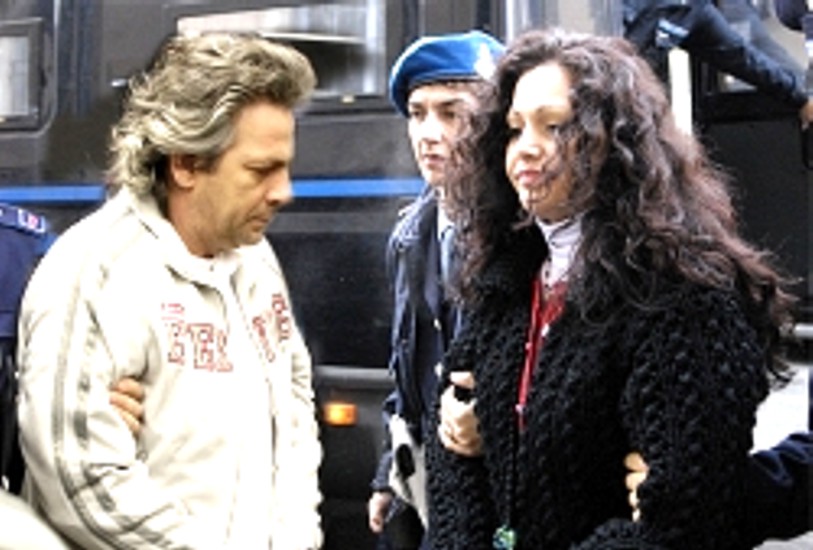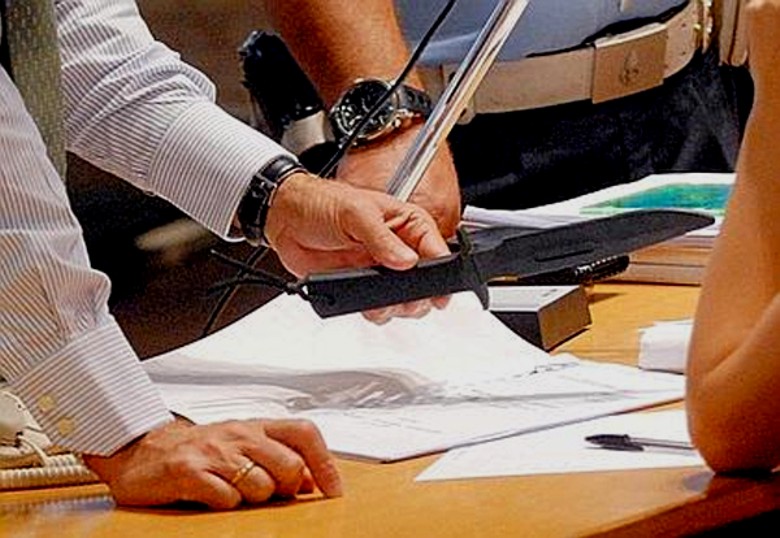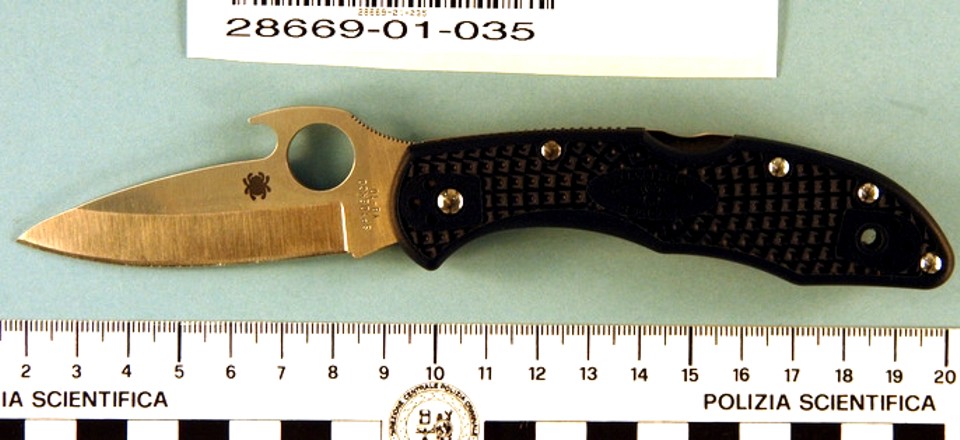
Category: Various hypotheses
Sunday, September 26, 2010
Knox Movie: Hardening Suggestions Panettiere & Dornhelm & Battles Have Been Sold A Total Dog
Posted by Janus

[Above: wannabee Amanda Knox impersonator actress Hayden Panettiere]
For three days the Knox machine in Seattle said nothing about the Lifetime movie.
On Monday Knox’s own lawyers in Perugia had said the proposed Lifetime movie was a bad concept badly timed. and lawyers for Sollecito indicated that this movie would be stopped by legal means as it could hurt them a lot more than it could ever help.
Maria Del Grosso, a lawyer who works with the criminal lawyers Amanda Luciano Ghirga and Carlo Dalla Vedova, reached by telephone by Adnkronos, called the idea “at least inappropriate”¦. you can not think about making a film when the case is judicially still open”¦. when you remove all this tension, we can work better on the appeals.”
Finally on Thursday there came a very muted claim of denial of involvement from the Knox machine in Seattle in the form of a Facebook Causes message apparently signed by Deanna Knox - a rather sad low-traffic page that, by the way.
.
“to all those who follow my sisters case and have heard about the new lifetime movie. here are some facts that we know now.
1.) yes, as it looks right now lifetime is making a movie about my sisters trial.
2.) yes, it looks like Hayden Panettiere is playing my sister in this movie.
3.) no, Hayden Panettiere has not visited my sister in italy, nor has Hayden or any of the ptoducers have had any contact with the family.
4.) will this movie follow the facts….at this point it is hard to tell, from reading news on it, so far it looks like it wont, calling my sister guiltridden and an infamous killer which none are true, we shall see how the tabloid lifetime comes up with.
till later this is all we know. -Deanna Knox”
Claim 3 would appear at first glance to be unambiguous. However, it does not exclude the possibility that some other people from say Lifetime have, for example, sat with the Knox machine, maybe for many hours. And in any case, which branch of the extended family is Deanna Knox referring to? The Knox branch, the Mellas branch, the Huff branch, or all three? Like many Knox statements, this one begs more questions than it answers.
Claim 4 also seems unambiguous. However, Deanna has clearly not been “reading news” with a great deal of care, since the attributed quotes were not made by the movie-makers - they were made by neutral media reporters writing up the story.
There seemed three possibilities in this instance: Firstly, that Deanna was a bare-faced liar. Secondly, that she is being kept “out of the loop” by other family-members and the Knox machine. Thirdly, that she really was telling the truth, the whole truth and nothing but the truth.
But now the CBS website is reporting that, contrary to earlier reports, Amanda Knox’s lawyers are not attempting to stop the movie being made. “Sources close to the case” (most followers of this case could have a good guess about who those “sources” might be) “told CBS News’ 48 Hours producers that Knox didn’t know about the film and has no plans to oppose it.
So it seems Mr Ghirga and Mr Della Vedova might have been told to please shut up.
It is now only Sollecito’s legal team that wants to stop it - and do they ever; see the post directly below. They have immense powers to do that.
Meanwhile we are hearing from an entertainment industry source that the script may not adhere at all closely to the truth, and may in fact in fact be a conspiracy theory snow job, with Italy and its meanie officials once again as the villains of the piece. (Good luck Lifetime in all the slander suits that will fly in face of such xenophobic and libelous rubbish.).
There are basically three components to the Amanda Knox story.
1) Amanda Knox’s life growing up troubled in Seattle and what the books say about it was described on Thursday here.
One problem with any movie that Curt Knox and Edda Mellas do not tightly control is the reports that are already out there (including in two of the books) of extreme family friction before and after the divorce - Amanda was not much more than a toddler at the time of the divorce.
Narcissistic sociopathy and narcissistic psychopathy, which psychologists have speculated Amanda might to some degree have (tests done on her in prison during the hearings were not released. but they helped sway a judge to not grant house arrest or bail), can apparently be triggered by early childhood trauma.
Another problem for Curt Knox and Edda Mellas if they do not control the film is the reports of Amanda’s quirky behavior over the years, which continued at the University of Washington and also in Perugia. It was most especially noticeable in the three days after Meredith’s murder, as her sentencing report points out, and again when she was on the witness stand in June 2009. And she has admitted to using drugs - in fact, she used that as a part of her defence.
2) Amanda Knox after she arrived in Perugia, where she had an almost uniquely unstructured and very under-funded student arrangement, where she had only a very light study load (especially compared to that of Meredith), where she was undoubtedly on drugs and possibly hard drugs (cocaine), where she was losing any friends in Perugia fast because of her loud abrasiveness, and where she was in danger of even losing her vital job - probably she thought she HAD lost it on the night, which would have sparked an angry storm in her just when Meredith died. (There are posts on all of these aspects here on TJMK.)
3) Amanda Knox and her team at trial. Amanda Knox and her mother did NOT do compellingly well on the stand, and the defence phase of the trial (unlike the prosecution phase) was weak, halting, indecisive, slow, and absolutely lacking in knockout punches. By the time of the verdict in December, Italian sympathy was hovering around zero.
Told truthfully, none of this - none - make her look like an attractive all-American girl. She was an apparently troubled person on drugs who was, with good reason, found guilty of a very vile murder.
And that’s it. This is not a patch on Meredith’s inspiring story - the super-achiever Meredith was the REAL victim here, in case Lifetime forgets. The less talented and less focused and less popular Knox was not a victim, ever, in any sense of the word. Except maybe in her own home.
Lifetime really seems to have the victims back to front.
Good film makers like Robert Dornhelm and Wendy Battles should really be taking this description above, and the Micheli and Massei Reports, as their point of departure, not the made up “facts” and ludicrous explanations of conspiracy theorists who have already done so much to anger half of Italy.
Especially if Dornhelm and Battles (and Hayden Panettiere) don’t want to see the lawsuits flying (there are several more slander suits already rumored to be in the works).
Meanwhile, in South London, the pain and misery continues for the family of Meredith Kercher, and an arrogant unfeeling Lifetime Television has still not bothered to respond to their very real and heartfelt concerns.
Common decency dictates Lifetime SHOULD have contacted Meredith’s family before this movie project passed step one. Since they chose not to do so, common decency now dictates that it becomes a matter of priority. That means reaching out to the Kerchers, today.
Their Italian lawyer, Francesco Maresca, has worked long and hard for them. He is easy to contact, and he will surely be happy to discuss the issue with Lifetime, and protect the Kerchers’ interests and make their feelings known.
Thursday, September 23, 2010
Entertainment Industry Buzz That Curt Knox And Edda Mellas Might Be Connected To Distasteful Movie
Posted by Peter Quennell

[joint images of Panetierre and Knox posted yesterday by Huffington Post]
We’ve heard buzz from a couple of sources in NYC that Amanda Knox’s parents might have had a hand in this Lifetime movie of Amanda Knox which is being raced into production.
One remarked that it was “informed speculation” and that some proof could be on its way to leaking out. Reports like this below in the Chicago Sun-Times that Hayden Panettiere has already visited Amanda Knox in Capanne Prison help to fuel the speculation. It seems very unlikely that she would have gained such access, if she did, without Knox’s parents assisting.
Former “Heroes’’ star Hayden Panettiere has visited Amanda Knox in prison in Italy - part of her preparation to play Knox in a TV movie.
Also fueling the speculation is the deafening silence of Amanda Knox’s family and friends in Seattle, in the face of the various Perugia lawyers’ very strong protests about the movie (see the post below) which we presume was genuine, and not simply blowing smoke in an orchestrated sort of way.
One problem with any movie that Curt Knox and Edda Mellas do not tightly control is the reports that are already out there (including in two of the books) of extreme family friction before and after the divorce - Amanda was not much more than a toddler at the time of the divorce.
Narcissistic sociopathy and narcissistic psychopathy, which psychologists have speculated Amanda might to some degree have (tests done on her in prison during the hearings were not released. but they helped sway a judge to not grant house arrest or bail), can apparently be triggered by early childhood trauma.
Another problem for Curt Knox and Edda Mellas if they do not control the film is the reports of Amanda’s quirky behavior over the years, which continued at the University of Washington and also in Perugia. It was most especially noticeable in the three days after Meredith’s murder, as her sentencing report points out, and again when she was on the witness stand in June 2009. And she has admitted to using drugs - in fact, she used that as a part of her defence.
And another problem is the sheer depraved cruelty of the crime, chillingly described in the Micheli and Massei Reports.
Filming is now said to start next month, although the point of that is not obvious if it is not to be aired before the second appeal, as the Perugia defence lawyers have said they will insist on. On how long that second appeal might take, our poster Cesare Beccaria points out that it could drag on for years.
Appeals should be faster, but not necessarily. In Italy the problem would be in Cassazione (3rd instance on law) where they can send the trial back to appeal for even a small procedural error. The case could go back and forth from appeal to Cassazione for years. Only Cassazione can confirm the verdict.
Media reports on the movie have all seemed to us pretty cool toward it. They have included phrases such as “all 3 convicted for murder, sexual assault, and obstructing justice”, “killer”, “convicted murderer” and so on. Only one used the inaccurate term “accused”.
Comments posted under online reports on the movie seem to have been very strongly pro-Meredith and her family, after the compelling outcry from her mother in London, and often strongly anti Amanda Knox, who seems to command almost no online sympathy or support any more.
None of Hayden Panettiere’s fans seem too thrilled. .In fact nobody who is a friend or fan of Hayden Panettiere seems to be speaking up to say this is a great career move for her, and at least some think she is being used - being duped - to misleadingly influence public opinion and maybe the court.
Finally, here is part of the description in Wikipedia of Lifetime Television which is certainly one of the most controversial cable TV channels in the United States for its incessant focus on one or other victim - which, in the case of the present film, may very well NOT be portrayed as poor Meredith.
Because of the obvious feminine slant to the network’s programming, Lifetime is often jokingly referred to as The Estrogen Channel, or “Wifetime” and many criticize the network’s over-reliance on formulaic made for TV movies, including the “women in jeopardy” or “woman scorned” theme common on films produced by the network, archived product which aired on the major networks in the 1980s and 1990s, and outside producers airing their work on the network.
Other comedy programs have satirized Lifetime’s sometimes sentimental programming. Family Guy once parodied their slogan, making it Lifetime: Television for Idiots, and in an episode had one of the main characters make a Lifetime-like film which oversimplified those themes, along with a film starring Valerie Bertinelli, called “Men are Terrible and Will Hurt You Because This is Lifetime”.
On August 27, 2009, A&E Television Networks, the owner of A&E Network, History and others, acquired Lifetime Entertainment Services. Though the channel is owned by another subsidiary company operated as a joint venture, Lifetime and its networks remain under the co-ownership of The Walt Disney Company and Hearst Corporation, though NBC Universal became partial owner of the Lifetime channels as well since NBCU already was a part owner of A&E Television Networks.
This movie REALLY should have been about the real victim Meredith, as her mother compellingly complained. THAT is normal Lifetime territory, not doing special pleading for her convicted killer. Hayden and writer Wendy Battles, please read up about Meredith, and see if you still feel the same way.
Read this post for example about what a super-high-achiever Meredith really was, and what a huge loss to the world her death is. And read the Massei Sentencing Report (link at top here) on how very, very cruel and depraved this crime against her really was.
[Below, second from left, is said to be Lifetime scriptwriter Wendy Battles]
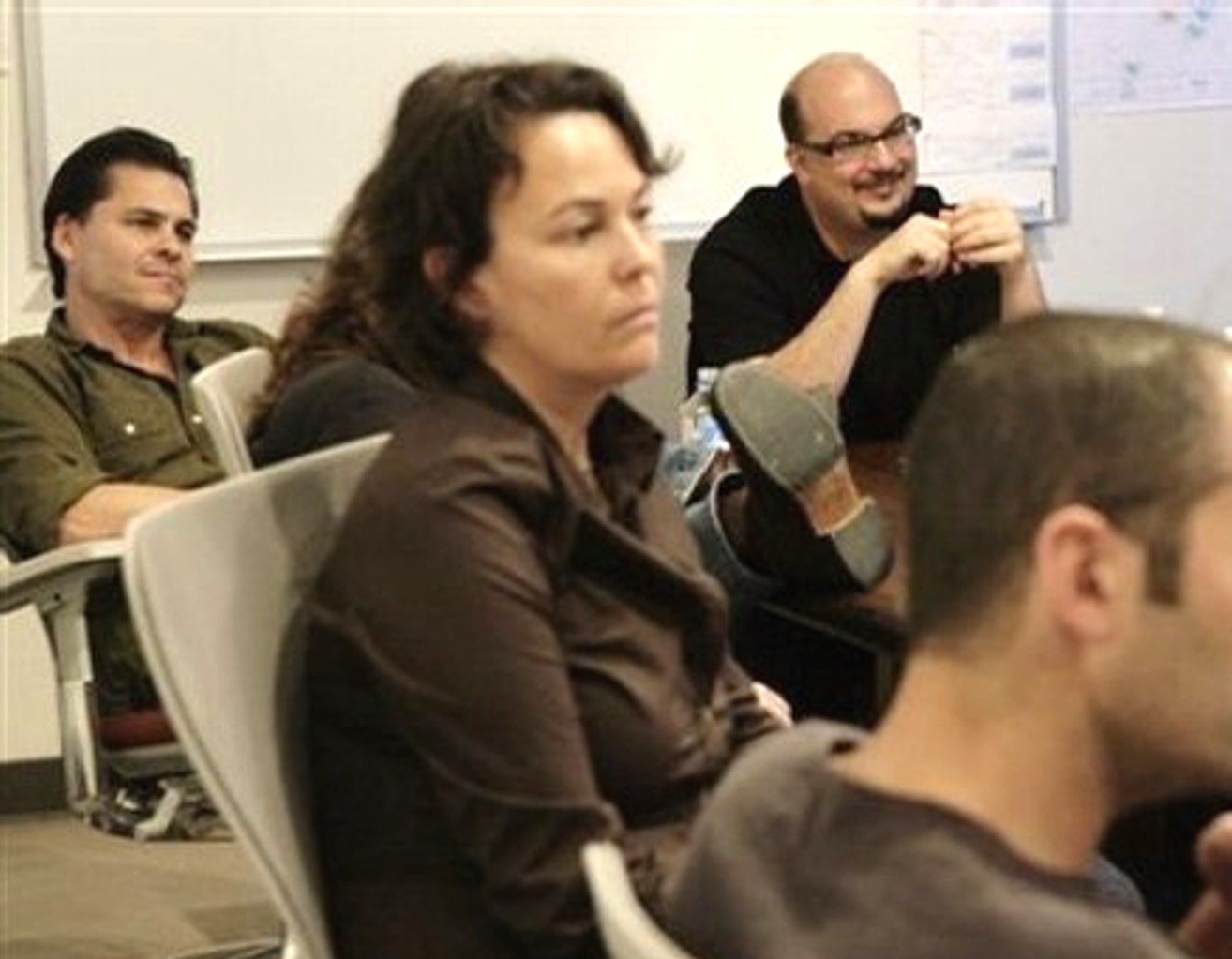
Tuesday, September 21, 2010
Could Movie Depicting The Real Knox And The Real Meredith Be A PR And Defense Disaster?
Posted by Peter Quennell
Already one movie is in the works. That one will be based on Barbie Nadeau’s excellent little book Angel Face: The True Story of Student Killer Amanda Knox
That British movie is likely to stay pretty close to the truth, Meredith as the real angel, and Amanda as at least in some degree the scary opposite. Barbie Nadeau seems to be in no doubt that Amanda was fairly convicted, but she also seems to think maybe there were factors going back to Amanda’s childhood (as did Paul Russell and Graham Johnson in Darkness Descending) that could have kinda set Amanda up, and could have been prevented by parents who cared.
Now we have this new made-for-TV movie (post below) by the Lifetime cable channel (with Oxygen, it has the largest ratio of women viewers) which for now at least is starring the popular actress Hayden Panettiere.
In 2003 the beautiful South African actress Charlize Theron (images above) who had previously played super-cool and super-sexy roles, played the Florida serial killer Aileen Wuomos in the movie Monster. If anything, Charlize Theron played Aileen Wuomos as more scary than she really was - and Charlize Theron won an Oscar for the portrayal.
Kathy Bates, Russell Crowe and Nicole Kidman also did very well playing roles strongly against type, along with quite a few others. An actor’s dream, to pull this one off.
Could Lifetime and Hayden Panettiere now have in mind a movie rather like Monster? Playing Amanda Knox as she really seems to be - only more-so?
This has already struck the Knox and Sollecito defense teams as not only possible but a real danger. One that could influence her first appeal late this November, and help to sink her second appeal late in 2011.
From today’s Italian Libero News website.
Lawyers for Amanda Knox and Rafael Sollecito announce a battle with the script of a film for television on the personal life and trial of the two young adults convicted in the first degree for the murder of Meredith Kercher.
Maria Del Grosso, a lawyer who works with the criminal lawyers Amanda Luciano Ghirga and Carlo Dalla Vedova, reached by telephone by Adnkronos, called the idea “at least inappropriate…. you can not think about making a film when the case is judicially still open…. when you remove all this tension, we can work better on the appeals.”
The same opinion was expressed by Luca Maori, Sollecito Raffaele’s defender with Ms Giulia Bongiorno, who said to AGI “I am absolutely opposed to a movie when the appeal process, expected to be long, has not yet even started.”
“It is unthinkable” added Giulia Bongiorno “to make a film when there is still an open case uncrystallized in truth. If the movie comes out before the end of the process of appeals, we will ask for its seizure,” said the lawyer.
Well, Amanda Knox’s parents and their PR manager David Marriott did want to push Amanda Knox out into the hard limelight, too sanitized to ever successfully pass the giggle test in the long run.
Now they and Knox’s (and Sollecito’s) long-suffering Perugia lawyers may be facing the first of a series of swings the other way.
Gullible, Callous, Or Simply Out For The Money? A Good Reporter Should Ask Her
Posted by The Editor
In fact, please ask actress Hayden Panettiere if she even knows the name of the victim? Does she even know that there WAS a victim?
Click above for the Daily Mail’s report. Meredith’s family are understandably deeply upset, and this decision to play an apparent charming psychopath convincingly convicted of a VERY cruel crime hardly bodes well for Panettiere’s career.
The family of murdered student Meredith Kercher yesterday criticised plans to turn her death into a Hollywood film. The movie will focus on Amanda Knox, the American student jailed for 26 years for the killing.
Actress Hayden Panettiere, best known as the cheerleader in the TV series Heroes, has been cast as “˜Foxy Knoxy’ in the film, called The Amanda Knox Story, which is due for release next year.
The Kerchers’ lawyer Francesco Maresca said the family was unhappy that a Hollywood version of the 2007 murder is being made. He said: “˜It is inopportune as the trial is still on going with two further appeals.’
Miss Kercher’s mother Arline said it was insulting for the film to be named after her daughter’s killer. She said: “˜I don’t see how they can make a film called The Amanda Knox Story when the story is really all about my daughter. It’s all very odd.’ A spokesman for the Knox family said they had no knowledge of the film, which is being aimed at a U.S. audience.
It will focus on events leading up to Miss Kercher’s death in November 2007 and the subsequent lengthy trial of Knox….
Producers of the film,which is being made for TV, said the Foxy Knoxy story was perfect movie material as it featured an “˜all-American’ girl at the centre of a murder involving sex and drugs.
The script for the Lifetime channel in the U.S. is being written by Wendy Battles, who has penned episodes of CSI New York and the crime show Law and Order.
The 21-year-old is one of the most sought-after young actresses in Hollywood.
An all-American girl? How much do they really know about her? Drug habits and all? Readers can discuss with fans and Hayden Panettiere’s managers on her forum on the popular and influential IMDB board.
At least one gushing fan there simply can’t wait for the movie.
Tuesday, July 20, 2010
That Widely Watched LA7 TV Interview With Giuliano Mignini - Herewith A Full English Translation
Posted by ziaK
This is a translation of the YouTube video posted by my fellow poster True North two weeks ago.
Many readers asked for a translation of what Mr Mignini said in that interview, and True North, who has pretty good Italian but is not a professional translator, requested some help from the translation team. The sound of the video is not always crystal clear but this appears to accurately reflect what was said.
Male interviewer: In the biological evidence, is there any one item which is the one which you consider, especially in terms of the trial, to have had the most value?
Giuliano Mignini: I think that, in terms of the trial, the most important were the knife, the bra hook and also the biological traces in the bathroom. From the point of view of the trial, the knife certainly links the two defendants and the victim. Therefore it was (interrupted).
Andrea Vogt: There was low copy number, and that’s not normal, is it, to use DNA when there’s low copy number?
Giuliano Mignini: However, I hold that those traces were nonetheless indisputable traces. That is, there was not an absolute huge amount, in terms that are perhaps more understandable [ndt: to an Italian speaker, “low copy number” is not necessaryily understandable, because it is an English term]. The trace might be really high, with a high quantity, or it may be very low, but however the trace may be, it was never reasonably explained in any other way. That knife was never touched by the victim. She was never (inaudible: possibly “at Raffaele’s”] during the period that the two young folk, the two defendants, knew each other. It was a very short period: we think the relationship was (inaudible) or a week.
Male interviewer: Certainly. However, (inaudible) limited, either a contamination in the place of the crime or a contamination in the laboratory? This is not meant as a criticism of the work, however it is a danger that we technicians have which we must confront.
Giuliano Mignini: Yes. Well, that point about the knife comes from the specific questions of Professor Finsi himself, and of the Superintendant (Parebiochi?), and it was clearly shown that that knife was collected with absolute”¦ that is, there was no possibility of exposure to contact [with the victim?]. Because it was found in Raffaele’s house and it was take with all precautions. This was shown in (inaudible). I was keen to show that (inaudible) that knife.
Andrea Vogt: Also the hook was very controversial because you found it 46 days after.
Giuliano Mignini: Yes, yes. I know. I understand. This, alas, can happen when there are places that are so full of objects, full of”¦ When one is doing an analysis of this type, it can happen that (inaudible) is moved. However, it remained within that room. And (Andrea Vogt interrupts). And then, if there is contamination, that means that Sollecito’s DNA was somewhere within that room. We’re still there (i.e. at the same conclusion). I think that all the evidence was limited [ndt: to the one place?], and the first findings were of an investigative nature. In particular, that includes the numerous contradictions made by Knox. Which were then repeated during the investigation, during the interrogation in jail, and in my opinion also during the questioning and counter-questioning in court.
Andrea Vogt: I want to talk a bit about the motive.
Giuliano Mignini: As a first impression of the [inaudible: crime?] it was clearly, it appeared clearly to be a crime of a sexual nature. It was extremely clear. A young woman, killed in that way, and almost completely stripped/naked.
Male interviewer: Excuse me, but on the contrary, at times I have heard attributed (inaudible) a different reason, a fight which ended badly, and then instead a transformation of the crime to put forward the idea that it was a sexual murder. Also because, in fact, the position of Rudy, who was however found guilty, also from the beginning changed a bit. There’s his responsibility.
Giuliano Mignini: Also Rudy gave indications which then changed a bit. Rudi too, for example, said that there was an appointment with Meredith. Then in later interrogations he said that Meredith had asked for him to be there, and (Male interviewer interrupts: The reconstruction [by Nabil?]: what could have happened?). Yes, according to me, there was a situation, a progressive situation of disagreement between the two girls. That seems undeniable to me.
Friday, July 02, 2010
Italy’s LA7 Is Running A Series On The Rare Phenomenon For Italy Of Female Criminality
Posted by Peter Quennell
Italy’s LA7 network is running a five-part series on notorious crimes in Italy involving women.
Compared to the US and most of Europe, Italy has only a small fraction of its population in prison at any one time. And an even smaller percentage of its female population. The involvement of women in serious crimes is rare in Italy - and the subject of considerable public interest.
The first segment (which is not yet on YouTube, although we have hopes that it will be) two weeks ago focussed on Amanda Knox’s involvement in the murder of Meredith. It was very highly rated.
The excellent American reporter Andrea Vogt was a main presenter, as she is throughout the LA7 series, and the Knox segment included interviews with Prosecutor Mignini and the lawyers for Knox and the other two perps.
The third segment, which aired this week, involved Antonella Conserva. You can see her in the image above and briefly in the LA7 report in Italian below.
She is married to Mario Alessi, who claimed earlier this year, to wide ridicule, that he had encountered Rudy Guede in prison, and that Guede had thoughtfully shared with him that Knox and Sollecito were not at the scene of Meredith’s murder.
Antonella Conserva and her husband, Mario Alessi were convicted four years ago of the kidnapping and murder of a baby (“Tommy”) and, although she was not even present when her husband murdered Tommy, she was sentenced to 30 years.
That is generally accepted in Italy as a reasonable sentence. This could be the new sentence for Amanda Knox, revised upward from 26 years, that the prosecution might win on appeal.
Absent any confession and show of contrition, which seems to us the smart way for Amanda Knox to go, reaction in Italy would probably be neutral or positive.
Like the name “Tommy” everyone in Italy knows the name “Meredith” and no last name is required. Speak up, Amanda.
Thursday, June 10, 2010
CNN Report On The Money Transfers That Bankrolled Van Der Sloot’s Trip To Lima
Posted by Peter Quennell
Sunday, May 30, 2010
Questions For Knox And Sollecito: Ten From Daily Beast As Knox Calunnia #2 Trial Starts
Posted by Peter Quennell

This Daily Beast report indicates that the cancelled jailhouse TV interview with Amanda Knox was a lot more firmed-up than Knox’s stepfather, Chris Mellas, seems to have claimed.
And it outlines the first phase of Knox’s Calunnia #2 trial which is based on charges brought by the interrogating police, all of whom testified at her trial that she was treated well during her interrogations as a witness and suspect. .
Click the image or link above above for the fine reporter Barbie Nadeau’s full article on some issues Knox has never been able to account for, including Knox’s callous skipping of Meredith’s memorial service.
The ten questions are all very tough, and each would also have been asked by the jury. Here they are:
.:
It’s back to court for Amanda Knox, the 22-year-old Seattle native currently serving 26 years in prison in Italy for sexually assaulting and murdering her British roommate, Meredith Kercher.
This week, Knox is expected to attend a preliminary hearing on slander charges lodged against her for accusing Perugia police of abuse. During her testimony at her murder trial last June, she accused the cops of slapping her on the back of the head during an interrogation just days after Kercher’s body was discovered in November 2007.
The police deny hitting her, and Knox’s own lawyers have never filed charges for the alleged abuse. If she is convicted of slander, a judge could add six years to her sentence….
Knox’s resurgence in the headlines was to coincide with a joint jailhouse interview she had granted to ABC News and the Italian broadcaster Mediaset’s Matrix program. But the bureau of prisons denied the interview in the final hour, effectively silencing Knox indefinitely.
A high-profile jailhouse interview with Knox is considered the Holy Grail by journalists covering the case, and the American and Italian networks have been vying for a chance to ask Knox a few questions on camera. Now it is unlikely anyone will get an interview before Knox’s appeal hearings this fall.
But if we did, there are a few questions we’d want her to put to rest.
1. Why did you and Raffaele Sollecito turn off your cell phones at the same time the night of November 1, 2007 and on again at the same time the next morning? You told the police that you and Raffaele slept late the morning of November 2, 2007, but phone records show that you both turned your phones back on very early that morning. How could that be?
2. Why were you bleeding? Your lawyers agree with the prosecution’s findings that at least one of the spots of Meredith’s blood found in the house where she was killed had your blood mixed with it. Your mother told me that you had your period. Your stepfather told others that your ear piercings were infected. Which was it?
3. Once you realized your mistake in blaming Patrick Lumumba for Meredith’s murder, why didn’t you tell the authorities? You told your mother that you felt bad about it, so why didn’t you alert an official so Patrick could be set free?
4. Why did you go with Raffaele to the police station on November 5? You were not called in for questioning. Did you realize at that time that you were both under suspicion?
5. Why weren’t your and Raffaele’s fingerprints found in your house after the murder if the two of you had spent time there that morning and the day before? Only one half-print on a glass in the kitchen has been attributed to you, yet you have claimed that you took a shower there that morning. How did you spend so much time there and leave virtually no trace?
6. Why did you take the mop and bucket from your house over to Raffaele’s house? You told the prosecutor during your testimony in June 2009 that you took the mop and bucket to his house to clean up a leak under his kitchen sink. But by your own testimony, the leak was miniscule and could have been easily cleaned up without it. What were you really doing with the mop?
7. What would you do differently if you had a chance to rewind the clock back to November 3, 2007? Would you go to the memorial service for Meredith? Would you still have gone to the police station with Raffaele? Would you have left for Germany when your aunt asked you to?
8. What do you think happened the night Meredith was killed? You have professed your innocence. Who do you think killed her and under what circumstances?
9. What do you really think of the Italian justice system? You told an Italian parliamentarian that you got a fair trial, and you even thanked the prosecutors for trying to solve the mystery of Meredith’s death, but your supporters at home in Seattle maintain that the Italian system is corrupt and unfair. What is your real view?
10. Is there anything you wish you would have said in court during your trial? You talked about your vibrator and about how you did not want an assassin’s mask forced on you. But in your final appeal after the closing arguments on December 4, 2010, why didn’t you say the words, “I did not kill Meredith Kercher?” Raffaele did when it was his turn to speak. Why didn’t you?
Our posting soon of the judges’ sentencing report will open up dozens of new questions for Knox. Such as: “How did you track Meredith’s blood into your own room and leave three traces revealed by luminol?”
Tuesday, May 25, 2010
The Chilling Killing Propensities Of Sollecito’s Various Knives
Posted by SomeAlibi
The few rather puerile websites trying to make the case that Knox and Sollecito were framed all have this one thing in common.
They are all of them a mile or more wide on the facts of the evidence - but only a millimeter or so deep.
Time and again on some point of evidence TJMK and PMF have gone far, far deeper than they have - and from then on, on that particular point, deafening silence is quite usual. Here is one very good example, on TJMK, highly incriminating in itself, and highly suggestive of when and how Edda Mellas first realised her daughter was guilty.
On that point of hard evidence, almost enough to incriminate Amanda all by itself, there has never been any real comeback. The PR campaign’s Wizard of Oz moves on.
Now we advance another in-depth analysis. This time it focuses on the really deadly nature of Sollecito’s various knives, and we’ll await the comeback if any with interest.
In effect, the deniers’ argument made is that Sollecito is not a collector or an aficionado, just a young man who might need to cut an apple with a pocket-knife. And he’s certainly not a hardcore knife collector, collecting fantasy-wish-list knives.
Carrying a pocket-knife above a certain size in public is illegal in Italy. But ignoring that technicality for a minute, let’s examine the knives of Raffaele Sollecito which were impounded during his arrest. Three knives, moving up in degrees of interest, not counting the very large knife prosecution witnesses identified as the murder weapon.
Knife Three
Take a look at the image up the top here. This knife actually hung above Sollecito’s bed.
It is a replica combat knife. The heavy t-bar protection is designed to protect the hand of the knife-user from slipping onto the blade when being used to stab another person, as well as to protect the user against another blade.
Blood grooves exist for only one purpose - as they imply, they are there for when one stabs someone deeply with the knife: they allow the blood to run out down the grooves. This breaks the seal and suction of the enclosing wound around the blade which makes the knife far easier to withdraw
That knife is specifically designed for stabbing people as well as cutting sentries’ throats etc. The female arm in the picture is Amanda’s by the way (you can find the zoomed-out version showing all of Amanda in the PMF gallery), as it was taken when she was being shown the knife in court.
She must have recognized it, of course, since it was from Raffaele’s bedroom, and would have been a rather noticeable discussion piece within view whenever Knox was in the room or laying on the bed.
Many teenagers and young adults put the objects of their highest interest and infatuation, from bands to film-stars, on their walls. Raffaele chose to put a knife designed for killing people on his wall.
It would be a lurking and incongruous presence on a small student-sized bedroom wall in the minds of the vast majority of people. The question of Raffaele’s degree of attraction to knives such that he actively chose to mount a replica combat knife on his bedroom wall doesn’t appear to need much further discussion.
And yet, it’s actually only less than a third of the equation as it was only a replica. Now let’s turn to two real knives - his so-proclaimed pocket knives - which Raffaele confirmed in his own words that he carried on him every day for years, and which tell a more subtle and deeper story.
First, consider what is the meaning of a pocket knife to you.
The phrase “˜pocket knife’ has been translated from the Italian from the transcripts / press coverage. For many, including myself, this will have conjured a mental image of a Swiss Army type knife or a simple blade and indeed this is the prevalent definition of a conventional pocket knife.
Let’s actually have a look at Raffaele’s “pocket knives” courtesy of pictures posted by poster Jools on PMF. These knives were impounded, one from the apartment and one, unbelievably, from Raffaele’s person at the Questura.
In the case of the latter, even Raffaele saw this as a devastating “own-goal” as we can read from his diary entry of 7 November 2007; “I’m not even able to offer guilt, given my deep fu**ing stupidity for the fact that I smoke cannabis I even forget what I have eaten and also for that I carry behind a knife to nock the tables and the trees and I carry it so often that I brought it also to the police headquarters.”
Knife Two
This is a 2.9 inch blade drop point, near spear point knife. At first glance (apart from the mark on the clip which should be ignored and was benign), the deniers camp might say “Well, look at it - it’s just a pocket knife even if it looks a bit sharp and so on ““ look, it’s even got a cute clip for the pocket, like on a pen.”
Let’s start there. The clip is actually a reversible one ““ it can be taken off and re-screwed to the knife to the user’s side / orientation of preference. This is already a proper knife rather than a cheap shop pick-up.
More obviously, the half-serrated edge to the blade for cutting is an active design (and purchase) feature.
Third, the “˜grind’ on the top the blade shows an aesthetic sensibility to the design but also serves a functional purpose for a cutting or stabbing use in terms of reducing friction.
Fourth, the serrations or (quite aggressive) “˜jimping’ on the top of the handle, just behind the blade are there to provide thumb grip.
Quite a lot of design features on this knife for a casual “pocket knife” one might think.
Which leaves us with the odd bar code thing at the top edge of the blade and the indistinct logo on the blade. Let’s see what that logo is with a little enhancing;
“˜Brian Tighe Design’. Brian Tighe?? Google sets us straight on who he is.
“You’d need a calculator to count the number of custom knife-makers who have jumped into the tactical fray over the past five years. You can tally the cream of the crop on two hands, being sure to earmark one of those digits for knifemaker Brian Tighe. In a matter of just a couple of years Tighe (pronounced “Tie”) has risen from the rank and file of edged weapons artisans to the rarefied air of the top 10 elite.”
A look at Tighe’s site shows that his own company’s knives sell for 500 dollars and up. He is a globally feted knife designer whose wait list for his knives was as high as seven years at one point.
So the design of the knife here is actually that of a noted master knife maker. Almost something one might collect, one might say. As loaded as Papa Doc Sollecito is, did Raffaele really spend over 500 dollars on such a knife?
Well no, actually, he didnt need to. This is a Columbia River Knife & Tool produced 811x series knife bearing Brian Tighe’s name. CRKT are a dedicated knife company who specialise in working with the world’s leading knife designers and producing the knives for a bigger market but still as proper aficionado pieces.
At this level of knife, there are extensive magazine, web and “˜user’ reviews. Knives like this are tested for resilience and sharpness including things like edge-on paper-cut tests where paper is cut through just like a razor from the side of a piece of paper held by one hand.
Such a knife is able to catch the edge of the paper and then slice straight through the width of the paper side-on without any tension in the paper. That’s what a knife like this is capable of. A “pocket knife” to me sounds like something picked up for 10 or 20 euro. The current model that replaced Raffaele’s now out-of-series model sells for about $80 at retail. Here’s the actual 2004 model that Raffaele had i.e. the same as the one above;
Worth looking at that for a second or two… Oh the bar code? It’s not a bar code, it a rectangular thumb stud you flick the knife open with. When you do, the knife goes to a locked position unlike many “pocket-knives”. In English speaking knife circles, these knives are not generally referred to as pocket-knives but are called “Tactical Knives” which are a cross-over of usage knives for outdoors / cutting etc but also for personal “protection”.
So, in addition to the wall-mounted replica combat knife, one of Raffaele’s daily carries (see diary / testimony) was a designer thumb-flicked locking tactical knife with jimping, top blade grind, switchable clip and a razor sharp edge costing about 80 bucks. That you can only carry in your pocket. Illegally. Some apple-cutter.
Let’s take a look now at the most worrying knife of all…
Knife One
At first glimpse, this “pocket knife” looks quite martial arts like, given the hole and the weird top edge of the blade and the spider logo.
The logo marks this as a Spyderco knife ““ a large premium knife manufacturer of tactical and many other types of knives. This particular model is a Delica4 Emerson Opener retailing for about $109.95rrp. Of particular note about this knife is the hole and the top edge. The hole, a Spyderco feature, allows a thumb to flick the blade open very quickly. This knife is about speed.
But actually the thumb hole is not the real speed feature ““ that is reserved for the top edge curl.
This is a truly specialist feature known as an Emerson Opener or “wave”. The idea is that the curl in metal catches on the edge of a pocket edge on drawing the knife and opens it immediately (see videos below).
This is a speciality feature licensed from Emerson knives ““ Emerson being another feted “˜name’ knife designer. The wave is only present on two of Spyderco’s 330 knives listed on their website ““ the Delica and the ¾ inch larger sister knife the Endura (“the best self defence knife in the world” according to one enthusiastic teenager on youtube). That’s how specialist it is.
The job of the wave feature is to provide the fastest opening knife in the world bar none ““ faster than a flick or spring knife in fact. This video (many similar to be found) gives a rather disturbing insight into what the real attraction of owning this knife is to a hardcore knife knut like Raffaele; (remember when you watch this for the first time that the knife is closed inside that pocket and also enable the sound on the embedded player below by clicking off the mute)
If I thought my son had a penknife, but then actually saw him with this, we would be having a very long chat..
“Enough!” the deniers say?! “You’ve still got it in for Raffaele haven’t you?” they say?! Despite the replica combat knife on the bedroom wall, the designer Brian Tighe Design CRKT drop-point and the Spyderco Delica4 with wave design)? “You’ve used prejudicial phrases like “hardcore knife knut” haven’t you?” they say?!
Sorry, but don’t look at me. They’re not my words.
They’re the words of Spyderco itself on its own webpage. See here and below.
Raffaele was out to impress Amanda and by his own admission both obsessive about her and a hardcore stoner. He also thought knives - proper knives with exclusive features by name knife designers not pocket knives were fascinating.
As with all of this case and any case, you REALLY need to look at the detailed evidence.
The overwhelming prevalence of skin-deep level of analysis / downplaying of this case by much of the deniers camp will lend and always has lent itself to people dismissing serious evidence as inconsequential based on their lack of understanding of what actually is in question.
The “mere pocket-knife” impression of Raffaele’s interest in knives is a clear case in hand. Raffaele’s father testified in court that his son carried a pen-knife. Some pen-knives or pocket-knives these really were…
As always with this case, when you take the time to look at the real detail, the reality you find is something far more disturbing…..
Tuesday, May 04, 2010
From The Book Darkness Descending: The Insights On Rudy Guede
Posted by Peter Quennell
Above and just below: Abidjan, the very attractive West African city where Rudy Guede was born and where he lived until he was five.
Darkness Descending includes this well-researched and revealing portrait below of Rudy Guede and the two traumatic experiences that really threw him: his moving in with the Caporali family, and the collapse of the restaurant in northern Italy which briefly employed him.
No claims here about Rudy Guede being a drifter or drug-dealer or dangerous knife-wielder or petty criminal.
None of those things are confirmed by the record or the Micheli report, and few or none in Perugia or Italy generally seem to believe Rudy Guede was the sole perpetrator or even the main perpetrator of Meredith’s death.

(Above: the downtown of Abidjan, the economic and former political capital of the Ivory Coast)
From Darkness Descending by Paul Russell and Graham Johnson (Pocket Books) pages 292 to 296
Unlike Amanda and Raffaele, the background of Rudy Hermann Guede seemed to inspire a degree of sympathy in readers and viewers.
At least once the undercurrents of reactionary racism had run its course and readers were able to identify with Guede the individual.
Guede had been dragged up a virtual orphan. He seemed to be luckless, directionless, prone to following others into trouble, his carers said. He’d never had a paternal figure to look up to or guide him.
That, and the fact that once he’d been caught he seemed to be at least trying to tell the truth about his involvement with Meredith, gave him a certain credibility.
He was often given a fair hearing in the papers for not trying to evade guilt by changing his story. Editors and readers seemed to appreciate that he had not relied on high-powered family connections to duck out of one of the most tragic cases that had ever come before them.

(From Piazza Italia at the south end of the walled city - Rudy Guede first lived off there to the south-east)
Guede came to Italy in 1992, when he was five years old. His father Roger had emigrated from the Ivory Coast a few years before at a time when the Italian economy needed new manpower to fuel the country’s post-industrial boom…
Roger Guede had trained as a teacher in the former capital city of the Ivory Coast, Abidjan, where his wife still lived with little Rudy, but in Italy he found work as a bricklayer.
Life was hard because of exploitation, denial of workers’ basic rights and rampant illegal labour.
After five years he was granted a regular resident’s permit and returned to Abidjan to his wife, to see if he could take the young Rudy back to Italy with him. She agreed that in Italy he would have a chance of a better life.
Roger and Rudy found a flat in the shabby low-lying suburb of Perugia called Ponte San Giovanni. The neighbourhood was not at the top of the hill, with its wide vistas, ancient buildings and air of academia.
Roger’s life had no room for aspiration or fanciful gap-year adventures. He settled for a seedy new-build on the valley floor near the railway station. An unhealthy stream meandered through the projects like a sewer.
Still, it was better than the shanty town where Rudy’s mother was eking out a bare existence.
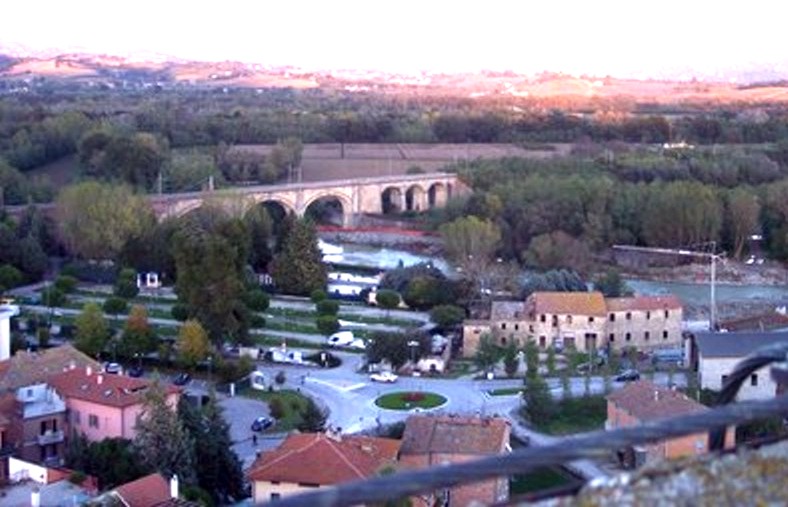
[Shots here and just below of Ponte San Giovanni, the town just to the east where Guede first lived]
New to immigration, Italy’s attitude to race relations has often been schizophrenic. Far-right extremists have been known to whip up dissension. But in Perugia, a small community like many that made up the backbone of Italian society, Roger and his son were welcomed.
His presence stimulated the lively cutiosity of Italians, not their hostility. The kindness of his neighbours and the willingness of social services to offer him childcare were proof of that, and he was free to hit the road to find building-site work.
During these absences Rudy was fostered by local families. One of his first full-time carers was a Mrs Mancini, who had been his maths teacher at school. She never lost interest in him and was to be like a second mother.
Rudy also struck up a lifelong friendship with her son Gabriele and another schoolmate, Giacomo Benedetti. The fabric of a closeknit Italian working-class community felt like a protective cloak and Rudy thrived.
His teachers and foster families all say that he was a quiet child, well behaved and responsible. He had moments of daydreaming stupidity, but no more than other kids.
He was good at basketball - tall, athletic and serious. The local professional basketball team was sponsored by one of Italy’s most successful companies, Liomatic, who manufactured coffee dispensers - a link that would later change the course of his life.
One day, Rudy’s dad went home to Abidjan to renew his passport, but civil war broke out when he was in the country and instead of spending two weeks away from his son he was trapped for six months, as strife raged in the Ivory Coast.
Back in Italy, the social services stepped in with a view to formalizing Rudy’s foster status and finding a long-term home for him.
Rudy was unhappy but he coped with the loneliness and uncertainty with admirable courage. He didn’t complain. And he was soon rewarded. Astonishingly, he was catapulted into the heart of one of Italy’s richest families.
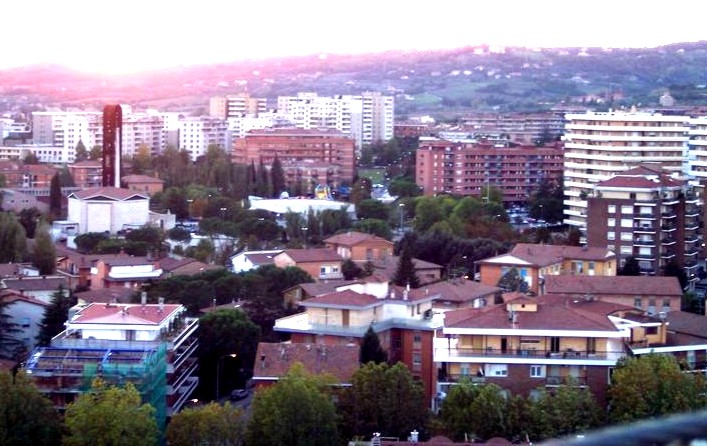
[Another shot of Ponte San Giovanni, where Guede in his early days apparently lived happily]
His change of fortune was like something out of the plot of the musical Annie. Rudy had met one of the Caporali sons at basketball. Now the family wanted to officially take him in as one of their own. He never lived with Roger again.
The change wasn’t smooth. Rudy found it difficult to adapt. When he moved out of Ponte San Giovanni, he lost touch with many of his old friends, which he found particularly hard.
They had been the bedrock in what had so far been a rather unstable family life. He soon missed the informality, the lack of pressure to succeed and the maternal bonds that Italian families are famous for.
It wasn’t long before his new father figure, Paolo Caporali, was calling Rudy ‘an inveterate liar’. He skipped school and spent his time in front of the television or on PlayStation. Caporali’s wife and kids were much kinder in their view:
Rudy was introverted and shy. He lied to protect himself, but not maliciously to hurt others or gain personal advantage.
The move from a poor area to the home of the super-rich Caporali family had confused Rudy and, to some degree, had embarrassed him.
His basketball trainer Roberto Segolini said Rudy was friends with everyone and never missed a training session. Where he could prove his worth and show success to his new high-status family, Rudy thrived.
With such a chequered school career, Rudy would find it hard to find a job that suited him once he left school. But at the age of nineteen he went to stay with an aunt in Lecco and landed a job as a waiter in Pavia.

[Shot of Lecco north of Milan where at age 19 Rudy Guede moved to live with an aunt]
Finally, he had found his way. He was ecstatic. He was now going to prove that he could knuckle down and stand on his own two feet. He thought about learning the trade and one day opening a restaurant.
But as soon as he settled in, the rug was pulled from under him - his employer was arrested and the business folded.
To someone with a fragile view of himself, this chance setback took on a great and doom-laden significance. Rudy blamed himself and worried about how he would explain his bad luck to the Caporalis.

[Shot of Pavia south of Milan where Rudy Guede worked as a waiter till the restaurant collapsed]
Confidence shattered, he fled back to Perugia in shame. It was July 2007 and the beginning of the long summer that would end in tragedy.
The Caporalis were desperate to bolster his self-esteem. In August they found him a gardener’s job at a restaurant they owned out of town.
He stayed with the Mancinis, where the father and mother made sure he got up early to catch the bus. But the rot had set in; he wanted to live where the excitement was.
He was distracted by the scallywag antics of the lads in Perugia, who never seemed to work but always had money, and by the beautiful students from allover the world who were descending on the University to find digs and party.
Amanda and Meredith would be among them. Once he failed to go to work for a whole week, claiming he had flu and snivelling unconvincingly over the phone. He was sacked.
He lived off his savings until 2 November, when the murder and his doomed getaway would end any hopes he had of turning his life around.

[Shot of Mainz on the Rhine between Frankfurt and Bonn where Rudy Guede was captured]



